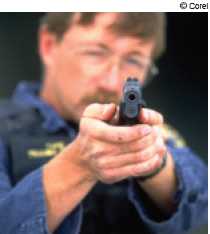

|
|
One-Shot Drops
|
| Size of Ammunition | Total Slain | While Wearing Body Armor | With Own Weapon |
|---|---|---|---|
| .22 caliber | 28 | 9 | 2 |
| .25 caliber | 18 | 11 | 1 |
| .32 caliber | 9 | 6 | 0 |
| .32-20 caliber | 1 | 0 | 0 |
| .357 magnum | 30 | 19 | 5 |
| .38 caliber | 65 | 28 | 5 |
| .380 caliber | 43 | 24 | 0 |
| .40 caliber | 34 | 24 | 11 |
| .41 magnum | 1 | 1 | 0 |
| .44 magnum | 11 | 7 | 1 |
| .45 caliber | 36 | 24 | 5 |
| .455 caliber | 1 | 1 | 0 |
| .50 caliber | 1 | 1 | 0 |
| 7.62x25 millimeter | 1 | 1 | 0 |
| 9 millimeter | 136 | 65 | 14 |
| 9x18 millimeter | 1 | 1 | 0 |
| 10 millimeter | 2 | 0 | 1 |
| Size not reported | 25 | 10 | 0 |
| Total | 443 | 232 | 45 |
Source: U.S. Department of Justice, Federal Bureau of Investigation, Law Enforcement Officers Killed and Assaulted, 2002 (Washington, DC, 2003).
|
Year
|
Justifiably
Killed by Victim Officer
|
Justifiably
Killed by Other Than Victim
|
Committed
Suicide
|
|---|---|---|---|
|
1991
|
2
|
6
|
5
|
|
1992
|
3
|
6
|
5
|
|
1993
|
2
|
7
|
6
|
|
1994
|
4
|
12
|
9
|
|
1995
|
4
|
5
|
8
|
|
1996
|
1
|
14
|
3
|
|
1997
|
2
|
6
|
12
|
|
1998
|
2
|
11
|
4
|
|
1999
|
0
|
5
|
5
|
|
2000
|
3
|
6
|
5
|
|
Total
|
23
|
78
|
62
|
Source: Compiled by members of the FBI’s Criminal Justice Information Services Division with data from U.S. Department of Justice, Federal Bureau of Investigation, Law Enforcement Officers Killed and Assaulted, 2002 (Washington, DC, 2003).
A firm understanding of what an officer possibly may expect if shot or severely injured during a violent confrontation with an adversary remains crucial. This includes heightening an officer’s aware ness about establishing a survival mind-set and practical measures to combat reactions to extreme stress concerning natural physiological, psychological, and emotional responses that occur in normal people during abnormal situations. Such training is imperative in conquering survival versus succumbing to an otherwise treatable, recoverable injury.
Effective survival training should provide a clear under standing of how authorized weapons and ammunition likely will perform under varying conditions to 1) strengthen officer confidence in personal skills with equipment and 2) prepare officers to efficiently and quickly incapacitate/control a threat against life. First and foremost, officers should possess a working knowledge about terminal ballistic performance of bullets when fired through intervening obstacles that they, by necessity, may have to shoot through and penetrate to incapacitate a violent adversary. Some common intervening obstacles encountered in law enforcement shootings can include heavy clothing; building materials, such as wood and drywall; automobile windshield glass; and sheet metal used in vehicle doors. Such obstacles may alter terminal projectile performance (i.e., the medium may plug or close the hollow point of a bullet, making it perform as a ball round or become deformed and, thus, limit penetration).
Officers also should know about ammunition performance at different, reasonable distances. Such training promotes greater understanding of agency policy when applied to different situations encountered in daily work experiences (i.e., when it is reasonable to shoot, not shoot, or seek alternate methods of self-preservation). Agencies using firearm ranges of 25 yards or fewer may consider options of periodically shooting at reduced-size targets, simulating a longer-distance handgun shot.
Finally, officers should possess a basic understanding of the human anatomy and related system functions from a three-dimensional perspective. Training should visually convey the placement and vulnerabilities of the cardiovascular system (heart, lungs, and blood-bearing organs) and the central nervous system (brain and upper spinal column). Knowledge of how these human systems likely will respond to low-velocity projectiles, such as from most hand guns, and high-velocity ones, such as from high-powered rifles, will augment officer awareness that reactions to being shot may not occur immediately. Perhaps more important, this information can help prevent officers from forming a false assumption or preconceived expectation that the adversary will be rendered immediately harmless following a well-placed shot from their firearm.

Well-rounded firearms training programs should include instruction and courses of fire emphasizing fundamentals of marksmanship and position shooting. However, from a survival aspect, additional training points require consideration. Examples include alternate courses of fire that possess phases unfamiliar to the officer, as well as a preset number of fired rounds, such as routinely employed in qualification courses and largely gathered for the purpose of establishing a “standard” of proficiency if needed in litigation. Alternate courses of fire (e.g., specialized combat courses), by design, should reinforce desirable behaviors and thought processes. Combat courses should necessitate officers shooting until they incapacitate the threat (target) or the threat ceases. This can help prevent, rather than encourage, psychological reinforcement and presumption that the threat will desist after firing a given number of rounds. If lethal force is warranted and appropriate under the circumstances, the officer must shoot until the threat ceases. Use of cardboard or paper targets, although economical, inherently forces personnel to perceive bullet impacts on a single plane of reference with out dimension—much different from a human simulation with dimension and placement of organs/skeletal structure of a body. An occasional mix of training on a three-dimensional target, such as clothed mannequins, preformed targets, and other devices limited only by imagination, may better demonstrate and encourage personnel to exercise critical-thinking skills for delivering optimal shot placement and effective ness. An example is a shooting scenario requiring accurate shot placement on a three-dimensional target at an adverse angle substantially different from the usual 90-degree target placement in many training scenarios due to range design, safety, and economy of training resource time.
Economical, three-dimensional reaction targets made of cardboard to resemble a torso are available. These targets, suspended by heavy string or cord to one or two inflated balloons inside the body of the device, can become lifelike by placing old clothing, such as a shirt or jacket, on the exterior. When one or both of the bal loons are struck by a bullet, the balloon pops and the target drops from its suspended position. Such an exercise emphasizes that the officer must aim at a distinct spot on the torso to achieve incapacitation, rather than merely shooting at the entire target.
New technology incorporated into training simulators portraying lifelike, real-time scenarios permits course designers to define the zones of immediate or quick incapacitation similar to the relative area on a human body. Additionally, designers can denote zones of incapacitation based on the angle and distance of the adversary from the officer, as well as scenarios representing body armor worn by the adversary.
Just as in the days of the American Old West when only the peace officers’ superb gun-handling abilities stood between them and the violent outlaws of their time, today’s law enforcement professionals still must rely on their firearm skills to protect their communities from similar lawlessness. Employing deadly force against another human being is not an easy choice, nor should it be.
However, when an individual is intent on causing grave bodily injury, even death, to officers sworn to uphold this nation’s laws, those officers must react responsibly and quickly to protect their communities and to avoid the loss of innocent lives, as well as their own.
The perpetuation of the one-shot drop by movies and television programs has no place in the real world of violent criminals bent on their destructive missions. Officers must realize that they have to continually hone their survival skills, always expect the unexpected, and never give up; they must protect themselves to protect their communities.
1 The FBI hosts four 10-week sessions each year during which law enforcement executives from around the world come together to attend classes in various criminal justice subjects.
2 “Physiologically, a determined adversary can be stopped reliably and immediately only by a shot that disrupts the brain or upper spinal cord. Failing to hit the center nervous system, massive bleeding from holes in the heart, or major blood vessels of the torso causing circulatory collapse is the only way to force incapacitation upon an adversary, and this takes time. For example, there is sufficient oxygen within the brain to support full, voluntary action for 10 to 15 seconds after the heart has been destroyed.” See U.S. Department of Justice, Federal Bureau of Investigation, Firearms Training Unit, FBI Academy, Handgun Wounding Factors and Effectiveness (Quantico, VA, July 14, 1989), 8.
3 Ibid.
4 U.S. Department of Justice, Federal Bureau of Investigation, Law Enforcement Officers Killed and Assaulted, 2002 (Washington, DC, 2003).
5 Members of the FBI’s Criminal Justice Information Services Division collected and supplied this information to the authors for this article.
6 U.S. Department of Justice, Federal Bureau of Investigation, Killed in the Line of Duty (Washington, DC, 1992); and, U.S. Department of Justice, Federal Bureau of Investigation, National Institute of Justice, In The Line of Fire: Violence Against Law Enforcement (Washington, DC, 1997).
7 Supra note 4, 44.
END OF ARTICLE